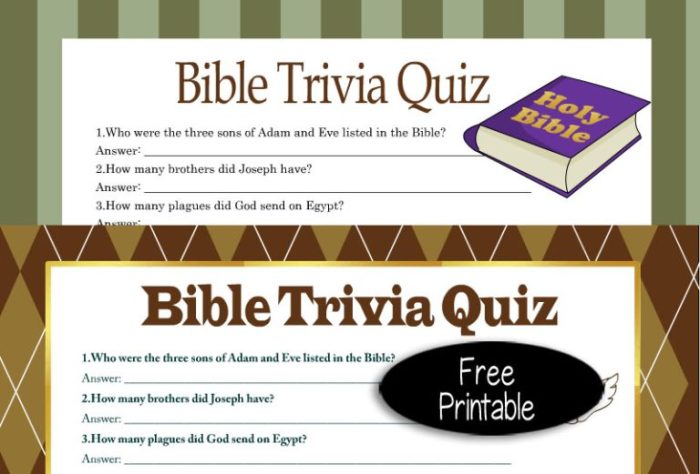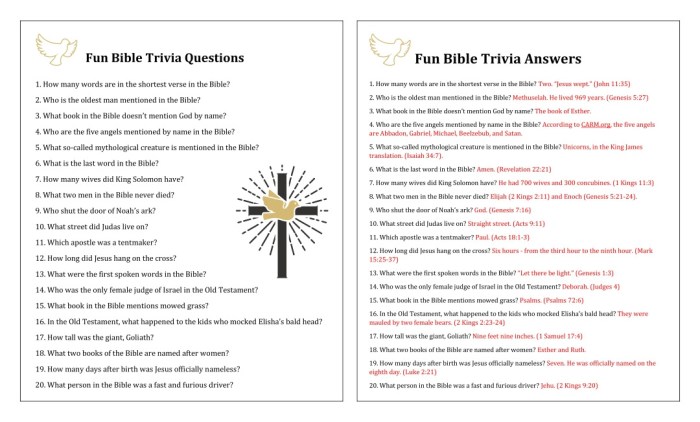Bible trivia fill in the blanks is a fun and engaging way to test your biblical knowledge. It can be used as a learning tool for students of all ages, and it can also be a great way to review your knowledge of the Bible.
Fill-in-the-blanks questions can be used to cover a wide range of biblical topics, from the Old Testament to the New Testament. They can be used to test your knowledge of specific Bible verses, or they can be used to test your general knowledge of the Bible.
Biblical Trivia Fill in the Blanks
An Overview
An Overview

Biblical trivia fill in the blanks is a type of game or quiz where players are given a list of incomplete sentences or phrases from the Bible, and they have to fill in the missing words or phrases to complete the sentences or phrases correctly.
In the world of Bible trivia fill-in-the-blanks, there’s a surprising connection to a lung model with larynx labeled . Just as the larynx is essential for speech, understanding the context of Bible verses can help us fill in the blanks with greater accuracy.
So, next time you’re tackling a Bible trivia challenge, remember that even the most obscure details can hold valuable clues to unlocking the correct answers.
This game is a fun and engaging way to test and improve one’s knowledge of the Bible and its contents.
There are many benefits to using fill-in-the-blanks as a learning tool. First, it can help to improve memory and recall of Bible verses and stories. Second, it can help to improve comprehension of the Bible, as players have to think about the context of the verse or story in order to fill in the missing words or phrases correctly.
Third, it can help to identify areas where players need more study or review.
Examples of Fill-in-the-Blanks
Here are some examples of how fill-in-the-blanks can be used to test biblical knowledge:
- Fill in the blank: “In the beginning, God created the ______ and the ______.”
- Fill in the blank: “The first man was named ______.”
- Fill in the blank: “The Israelites were led out of Egypt by ______.”
Creating Effective Fill in the Blanks Questions

Crafting effective fill-in-the-blanks questions requires careful consideration to ensure clarity, accuracy, and engagement. Here are some guidelines to follow:
Clarity and Unambiguity
- Use clear and concise language, avoiding ambiguous or confusing terms.
- Provide sufficient context to help learners understand the question’s intent.
- Ensure that the blank space is appropriately sized to accommodate the missing information.
Varying Difficulty
To accommodate different learners, vary the difficulty level of questions. Include questions that:
- Require basic knowledge and recall.
- Test understanding and comprehension.
- Challenge critical thinking and analysis.
Coverage of Biblical Topics, Bible trivia fill in the blanks
To provide a comprehensive assessment, cover a wide range of biblical topics, including:
- Old Testament narratives and teachings
- New Testament events and doctrines
- Key biblical characters and their significance
- Important theological concepts and principles
Designing Engaging Fill in the Blanks Activities

To make fill-in-the-blanks activities more engaging and interactive, consider incorporating the following techniques:
Incorporating Multimedia Elements
Multimedia elements can enhance the learning experience and make the activities more visually appealing. Consider using:
- Images or videos to illustrate concepts
- Audio recordings to provide context or explanations
- Interactive simulations or games to make the activity more hands-on
Promoting Collaboration and Teamwork
Fill-in-the-blanks activities can be used to promote collaboration and teamwork. Encourage students to:
- Work in pairs or small groups to complete the activity
- Share their answers and discuss different perspectives
- Provide feedback and support to each other
Evaluating the Effectiveness of Fill in the Blanks
Evaluating the effectiveness of fill-in-the-blanks activities is crucial to ensure they meet their intended learning objectives. Regular assessment helps educators identify areas for improvement and tailor future activities to better engage and benefit learners.
To collect feedback from learners, educators can use various methods, such as surveys, questionnaires, or informal discussions. These feedback mechanisms allow learners to provide their perspectives on the clarity of instructions, relevance of content, and overall effectiveness of the activity.
Role of Data Analysis
Data analysis plays a vital role in refining fill-in-the-blanks activities. By analyzing the feedback collected from learners, educators can identify common errors, areas of confusion, and aspects that need further clarification. This data-driven approach enables educators to make informed decisions about modifying the activity’s content, structure, or difficulty level to enhance its effectiveness.
User Queries: Bible Trivia Fill In The Blanks
What are the benefits of using fill-in-the-blanks as a learning tool?
Fill-in-the-blanks questions can help you to improve your memory, your concentration, and your critical thinking skills.
How can I create effective fill-in-the-blanks questions?
When creating fill-in-the-blanks questions, it is important to make sure that the questions are clear and unambiguous. You should also vary the difficulty level of the questions to accommodate different learners.
How can I design engaging fill-in-the-blanks activities?
There are many different ways to design fill-in-the-blanks activities. You can use multimedia elements, such as images or videos, to make the activities more engaging. You can also create activities that promote collaboration and teamwork.